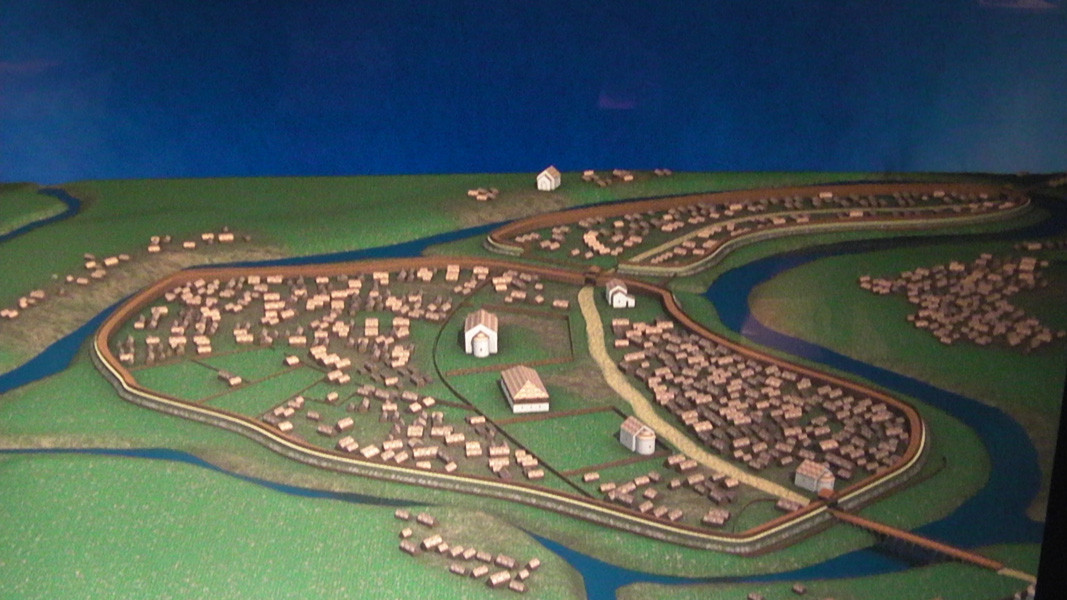Every year on 24 May, the day of Bulgarian education, culture and the Slavic alphabet, Bulgarians from the Czech Republic, Slovakia, Hungary, Austria and Germany throng to the village of Mikulčice in the Czech Republic. A lot of other people come too, from various Slavic and Orthodox communities from around the world.
But why there, in the village of Mikulčice do they go to honour Saints Cyril and Methodius? On ordinary days, on their way to Prague, Brno or elsewhere, travellers rarely choose to take the out-of-the-way provincial roads leading to Mikulčice. But in 2009 a monument was erected in the local park to the two brothers – Cyril and Methodius. The reason – a small book “The secret of the grave of Methodius, Moravian archbishop“, with author, Czech archaeologist Prof. Zdeněk Klanica. He formulates some intriguing hypotheses linking Methodius with the village. Mikulčice is thought to have been the capital of Great Moravia, called by later authors Veligrad, Velehrad, meaning “big rock“. It was in Great Moravia that the brothers Cyril and Methodius pursued their historic mission in 863-867, a time when divine service in the Slavonic language was introduced, as was the first Slavic alphabet.

Since 1954 archaeological excavations at Mikulčice went on for 38 seasons, and in the 1970s this was the biggest dig in Europe. Over an area of 10 hectares a town was uncovered, spreading to 3 islands in the area frequently flooded by the waters of the strategic river thoroughfare – Morava. The foundations of a big royal palace, 12 churches. 3 bridges. 2 ports, and over 2,500 tombs were unearthed. Inside the palace complex there is a grand basilica, and more than 550 tombs near the two buildings, which have all been studied. But Klanica takes particular note of tomb No. 590 which is inside the grand basilica. The researcher brought forth the bold hypothesis that it is here, in 885, that Methodius, archbishop of Great Moravia was buried.

Whether it really is Methodius that was buried in tomb No. 590 and whether Velehrad really is close to Mikulčice is a matter of scientific dispute. The search for the saint’s relics has been on for two centuries, but their weherabouts remain a mystery. Others are looking for Velehrad and Methodius‘ grave further north up the river. Klanica thinks that the settlement near Mikulčice was called Morava. But other authors offer various hypotheses of what it was once called.

People unfamiliar with history are surprised by theway the Catholic Church and the local people pay homage to the holy brothers – as spiritual leaders and Orthodox missionaries from the time before the Great Schism of 1054. But there is one more fact that illustrates the scale of their mission in Great Moravia – that 11 centuries later it is so much more than an academic issue, that Cyril and Methodius are still at the centre of hot political, cultural and religious discussions in the Czech Republic and Slovakia. After the excavations were over, the historical location near Mikulčice was turned into a well-tended but prosaic museum park. One of the men who ushered in the change is Bulgarian diplomat Zrdavko Popov. As ambassador to Prague he has a major contribution to the creation of the monument to the two holy brothers in Mikulčice. Author of the monument is the Bulgarian Emil Venkov who lives in Slovakia.
Even if it is not 24 May, Mikulčice is a great destination. Today, the border between the Czech Republic and Slovakia runs along Morava River though it is a border with free passage. The passage of time has spared a pearl of medieval culture close by that has survived from the times of Cyril and Methodius and their mission in Great Moravia – the Saint Margaret of Antioch church on the opposite bank of the Morava, close to Kopčany village. The cult of St. Marina/Margaret is Byzantine. Further west, veneration of this saint was introduced late on – after the 9th century, and she was named Margaret. But maybe this cult was introduced by Cyril and Methodius? There is no way of knowing. What is certain is that St. Methodius has been there, and has served in the temple. And his spirit is still there, locals still call the Saint Margaret of Antioch – Methodius’ church.
The first modern Christmas was celebrated in Bulgaria in 1879. It followed a European model with a Christmas tree, ice skating and gifts. At that time, the young Alexander Battenberg, who had just become the Prince of Bulgaria, took it upon..
Ukrainian sculptor Mykhailo Parashchuk was born on November 16, 1878. He crafted the ornaments of some of the most emblematic buildings in the Bulgarian capital. Mykhailo Parashchuk was born in the village of Varvaryntsi, at the time within..
On October 19, the Bulgarian Orthodox Church honors the memory of the humble hermit from the Rila mountain and heavenly patron of the Bulgarian people and Bulgarian doctors. Called "an earthly angel" and "a heavenly inhabitant" during his lifetime,..

+359 2 9336 661
